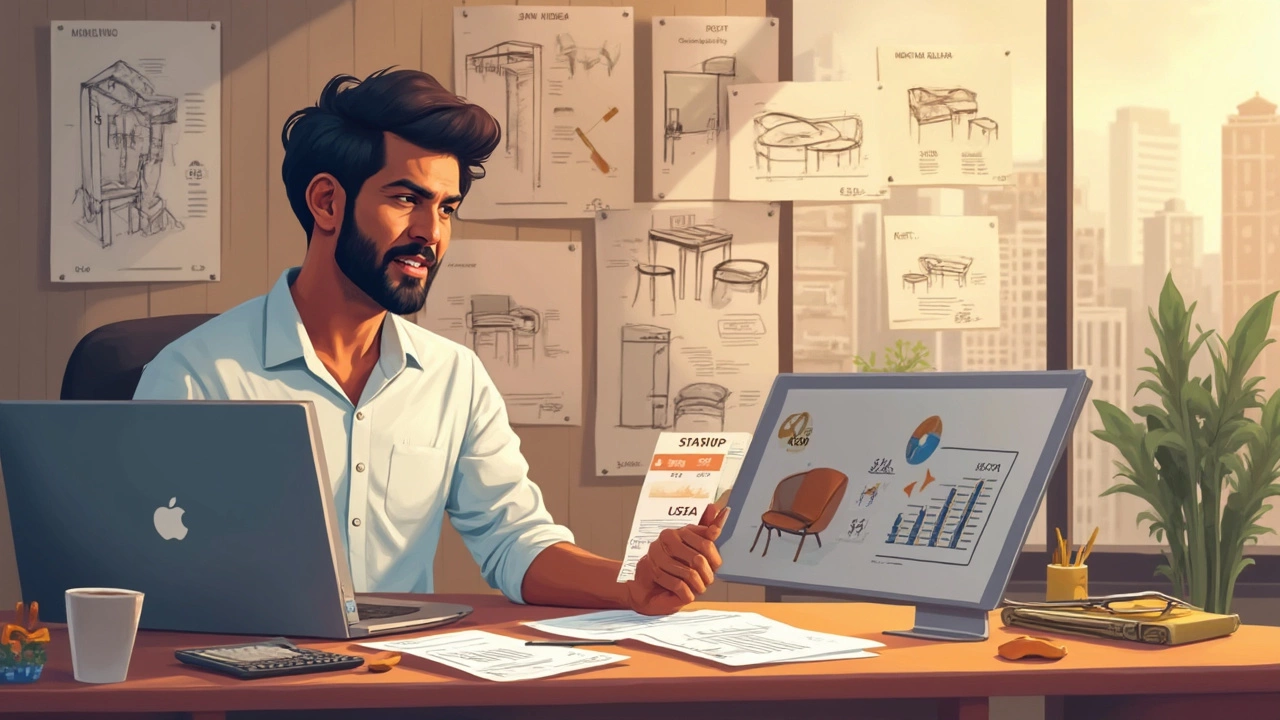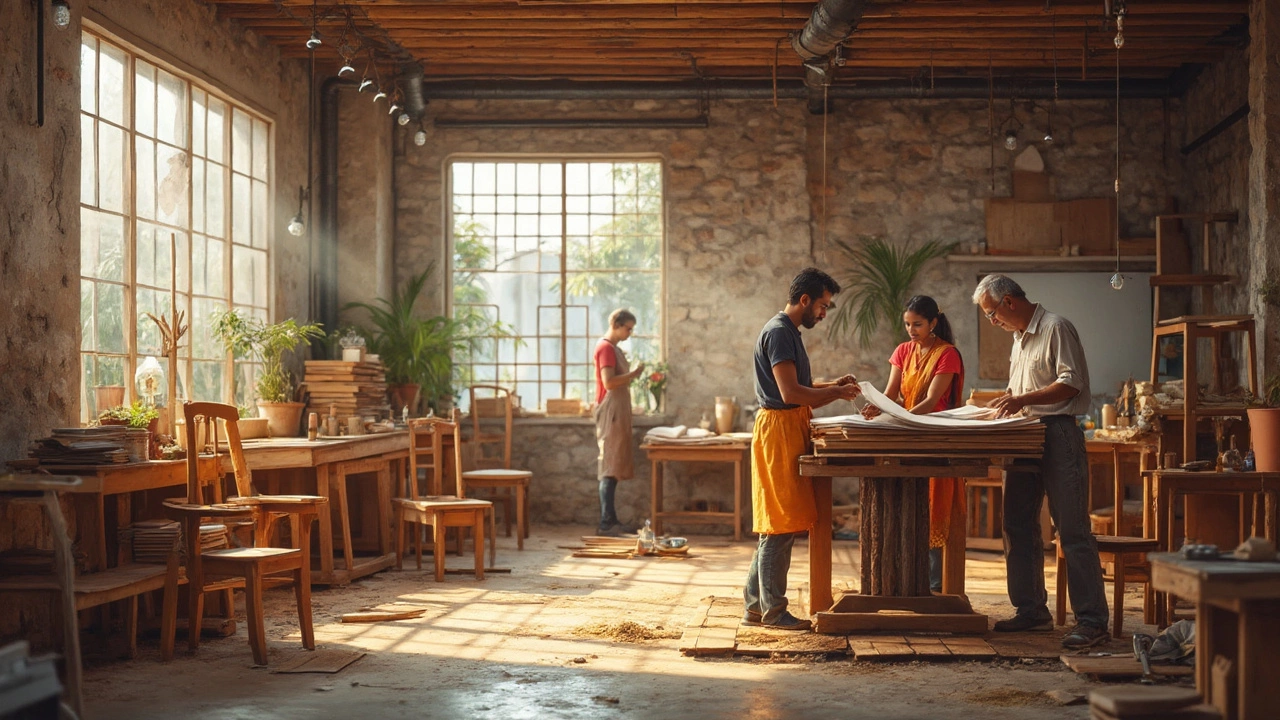Setting up a furniture business in India? You’ll want real facts, not vague ideas. Most founders are surprised at their first budget—expenses come from places you didn’t even think about. You need more than just a space and some wood; every step drains your wallet if you’re not careful.
The first truth no one tells you: getting started isn’t cheap, but it’s also not impossible. Small workshops in tier-2 or tier-3 cities can start with as little as ₹5–10 lakhs, while serious manufacturing units with modern tools, showrooms, and a web presence might need ₹50 lakhs or more. Your choices shape your costs, and cutting corners on the wrong things can haunt you later.
This isn’t just about money, either—setting up legal paperwork, sourcing the right plywood, finding skilled carpenters, and getting your first order all come with their own price tags. Miss one of these, and your business can stumble before it finds its feet. Dreaming of a fancy showroom in a metro? That alone can eat up a chunk of your budget through rent and interiors.
- How Much Money Do You Need to Start?
- Workshop, Tools, and Raw Materials
- Labor, Licenses, and Daily Expenses
- Marketing, Branding, and Online Selling
- Unexpected Costs and Smart Money-Saving Tips
How Much Money Do You Need to Start?
Let’s get right to the numbers. When you’re planning to enter the furniture business cost game in India, amounts can swing a lot depending on how big you want to go. Here’s what most first-timers miss: the minimum investment isn’t just about buying tools or renting a shed — you need to budget for everything from raw materials to setting up your GST and labor laws.
So, how much do you actually need? If you’re going lean, setting up a small workshop in a less crowded city, your starting cost can look something like this:
| Expense | Budget Range (₹) |
|---|---|
| Workshop Rent/Lease (per year) | 1,20,000 – 3,60,000 |
| Machinery & Tools | 2,00,000 – 5,00,000 |
| Raw Material (wood, hardware, polish, etc.) | 1,00,000 – 3,00,000 |
| Labor Wages (for 3-5 people, 3 months) | 1,00,000 – 2,50,000 |
| Licenses & Registrations | 30,000 – 80,000 |
| Electricity & Utilities (setup + 3 months) | 30,000 – 70,000 |
| Initial Marketing/Website | 20,000 – 60,000 |
| Miscellaneous/Hidden Costs | 50,000 – 1,00,000 |
Add it up and a basic setup is possible for around ₹5–10 lakhs. If you’re aiming for a bigger operation — large metro locations, branded showroom, hiring designers, setting up a bigger web store — your budget easily jumps past ₹20–50 lakhs, sometimes even crossing ₹1 crore if you’re thinking seriously big.
One crucial thing: leave a cushion for unexpected headaches. Prices of wood and labor keep changing. Permits or legal delays? Those can sneak up on you. Always plan at least 10–20% extra funding over your main estimate, or you could find yourself stuck mid-project. Getting the money right in the beginning sets up your business to survive those first tough months.
Workshop, Tools, and Raw Materials
Let’s get real—you can’t start making furniture without a physical space, a set of tools, and a steady supply of wood or engineered boards. Picking your workshop location decides half your headache. Rental rates bounce a lot between cities—think ₹15,000–₹30,000 per month in smaller towns for about 1,000 sq ft, but easily ₹50,000 or more in metro areas. Warehousing locations in industrial areas are cheaper, but you’ll sacrifice walk-in customers if you plan to have a retail front.
Tools and equipment will take a big bite out of your startup cash. Here’s where it adds up fast:
- Basic hand tools (hammers, saws, chisels): ₹50,000–₹1 lakh for decent quality
- Electrical machines (table saw, jointer, thickness planer): ₹1.5–₹3 lakhs for entry-level Indian brands
- Spray painting and finishing gear: ₹40,000–₹1 lakh
- Assembly/workbenches and safety gear: ₹30,000–₹50,000
Unless you go fully handcrafted (which is slow and won’t scale), you’ll need at least 3–4 core power machines to get going professionally. Don’t overspend at the start; many successful shops start with secondhand machinery and upgrade as orders grow.
Then comes raw material—your biggest ongoing cost. For most furniture, you’ll use plywood, MDF, solid wood, and hardware (hinges, screws, handles).
| Material | Approx. Price (per sq. ft.) |
|---|---|
| Plywood (ISI grade) | ₹65–₹110 |
| MDF | ₹30–₹55 |
| Solid Wood (Teak, Sheesham) | ₹200–₹350 |
| Laminates/Veneers | ₹22–₹120 |
| Basic Hardware Set | ₹500–₹2,000 per item |
Here’s a trick: don’t buy huge stocks just to get lower rates. Indian wood prices can be volatile. It’s safer to tie up with two or three trusted suppliers rather than depending on one. Also, negotiate credit periods; most suppliers in the furniture business are willing to offer 15–30 days of credit once you’ve built a track record.
Quick tip: Factor in shrinkage, defects, and offcuts when estimating material costs—first-timers usually underestimate this and run short mid-project. Always over-order your core boards and hardware by 10% to stay safe. Having these cost numbers and practical tips sorted early will help you dodge expensive mistakes as you get your shop off the ground.

Labor, Licenses, and Daily Expenses
If you want your furniture business to run smoothly, you can’t skimp on labor and paperwork. Wages make up a big chunk of your regular costs. In 2025, a skilled carpenter in India usually asks for ₹18,000–₹25,000 per month, depending on experience and city. Helpers, polishers, and finishers are a bit less, around ₹10,000–₹16,000 monthly. Don’t forget, if you want your shop to run like clockwork, you need at least three or four solid folks on the team from the start.
Paperwork looks boring, but going legit matters. Your furniture business cost will include getting a GST registration (about ₹3,000–₹6,000 if you hire a consultant), trade license from the local municipality (₹2,000–₹8,000 yearly, based on city and shop size), and small expenses for factory registration or environmental clearances, if you plan a bigger operation. Add MSME (Udyam) registration if you want loans or subsidies; it’s free, but can save you big money later.
Daily expenses might seem small at first, but they add up fast. Electricity, water, and rent can bite off a neat share. A small workshop’s monthly utility bill is at least ₹3,000–₹6,000, but heavy machinery or air conditioning can double it in the summer. Rent varies wildly: in a smaller city, you can get basic space for ₹10,000, but a good spot in Bengaluru or Mumbai easily costs ₹40,000 or more a month. On top, you’ll spend on transport, packaging, cleaning, and keeping some cash ready for last-minute spend.
| Expense Type | Estimated Monthly Cost (₹, 2025) |
|---|---|
| Skilled Carpenter Wage | 18,000–25,000 |
| Helper/Finisher Wage | 10,000–16,000 |
| Rent (Workshop) | 10,000–40,000 |
| Utilities (Electricity/Water) | 3,000–12,000 |
| Licenses (Annual Avg.) | 600–1,200 |
Here’s a tip: always keep a small buffer fund, at least a month’s extra expenses, for surprise problems. This lets you pay your workers on time, even if a client delays payment or if work slows down for a while. Avoiding staff turnover can be a huge money-saver in the long run.
Marketing, Branding, and Online Selling
If you think great carpentry alone brings customers, you’ll be disappointed. You need to get your name out there—fast. Whether your furniture is funky, classic, or budget-friendly, people need to know what makes you different from the next guy.
Here’s the deal: **furniture business cost** goes up a notch when you start investing in marketing and branding. But this isn’t wasted money—it’s fuel for your growth. Setting aside a solid budget for marketing can mean the difference between empty chairs and a full order book. Even solo carpenters now pay attention to Instagram and WhatsApp Business. Customers go online before they even step into a store, so your web presence must be on point.
- Name and Logo: Registering a catchy name and a simple, memorable logo can run from ₹5,000 to ₹25,000, depending on whether you use freelancers or agencies.
- Social Media & Catalogs: Basic social media advertising (Instagram/Facebook) can start at ₹2,000 per month. If you want slick photo catalogs, budget at least ₹10,000 for a professional photographer (or DIY with a smartphone).
- Website & Marketplace Listings: A basic website with product listings will cost around ₹10,000–₹50,000. Some businesses sell through marketplaces like Pepperfry, Urban Ladder, or Amazon—these platforms charge commissions (typically 8–20%).
- Offline Branding: Hoardings, flyers, and participation in local exhibitions can add ₹10,000–₹2 lakhs to your first-year expenses.
If you’re looking to get noticed by homeowners or interior designers, ranking high on Google and listing your shop on Google Maps is critical. Spend a few thousand on SEO and online ads, and you’ll see your store visits increase, even if you’re tucked away in a busy city lane.
| Marketing Activity | Estimated Cost (₹) |
|---|---|
| Logo & Branding | 5,000 – 25,000 |
| Website Development | 10,000 – 50,000 |
| Social Media Ads (monthly) | 2,000 – 15,000 |
| Professional Photography | 10,000 |
| Marketplace Commissions | 8% – 20% per sale |
| Offline Events/Fairs | 10,000 – 2,00,000 |
One smart tip—track your spending and response rate from each effort. Sometimes, a ₹2,000 ad can bring three new inquiries, while a pricey fair might flop. The sweet spot is usually a mix: strong online presence combined with smart local outreach.

Unexpected Costs and Smart Money-Saving Tips
The thing about starting a furniture business in India is that plenty of trips and bumps pop up where you least expect. For example, a small jump in plywood prices can wipe out your margins overnight. Just last year, MDF board rates shot up by 20% without warning. Small businesses took a hit because they hadn't factored sudden material price swings into their budgets.
Then there's the stuff nobody tells you—like bribes for basic municipal clearances in some cities, or surprise charges for GST compliance and e-way bills. Hidden penalties for late PF and ESI payments can also eat into your wallet if you’re hiring workers. If you're thinking about selling online, platform commission fees, return shipping costs, and even quality certifications aren't just optional extras—it’s mandatory if you want to list on a platform like Pepperfry or Urban Ladder.
Want to save money and still look pro? Here are some things that actually work:
- Buy raw materials in bulk during off-season—rates are lower, and you can negotiate hard with vendors.
- Look for used woodworking machines. Good second-hand tools from OLX or local auctions can cut your startup cost by 30% or more.
- Pay skilled workers on a per-piece or part-time basis until orders are steady. This keeps salary expenses flexible.
- Share transport with other manufacturers in your area if you’re delivering items within city limits—one truck, split cost.
- Think digital for marketing. Creating a basic Instagram page and WhatsApp catalogue costs peanuts compared to a fancy website, and you still reach thousands of local buyers for free.
If you’re watching every rupee, track every single expense. Even things like screws, glue, and wrapping material add up quickly. And always have a backup fund for the odd accident or customer who refuses to pay on time. The real secret? The biggest savings rarely come from cutting corners on quality. They come from being street-smart and thinking ahead about the costs waiting around the corner—including the ones you can't see right now but furniture business cost always include.
